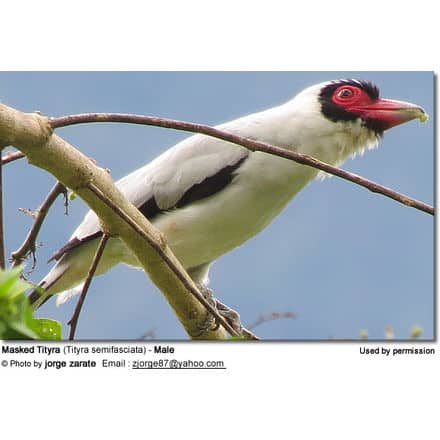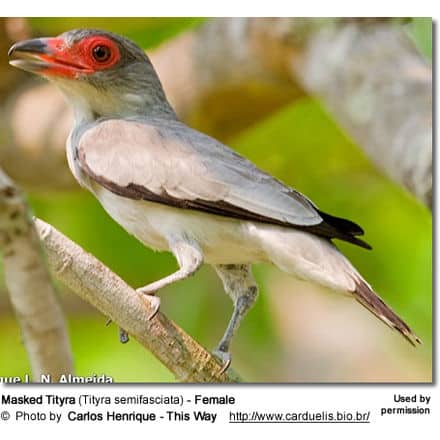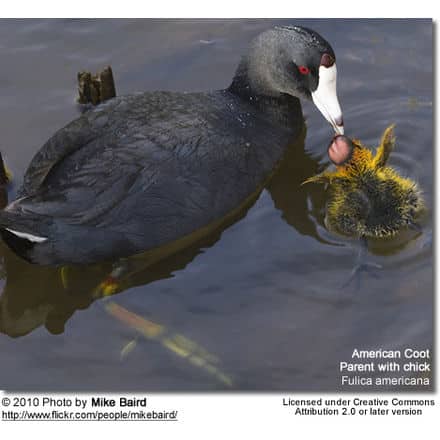Masked Tityra
The Masked Tityra (Tityra semifasciata) is a medium-sized perching bird that belongs to the American bird family Tityras – which occurs in Middle and South America.
Distribution / Habitat
The Masked Tityras occur naturally in the forests and woodland areas in Mexico, where they come within 250 miles of the United States border.
Their range stretches south through Central America to northwestern and central South America, as far south as Paraguay.
Their preferred habitat includes forest clearings and edges, second growth and other semi-open habitats, such as plantation shade trees.
They are usually seen alone or in pairs, perched conspicuously as they forage for food.

Subspecies and Ranges:
- Masked Tityra (Tityra semifasciata semifasciata – Spix, 1825) – Nominate Form
- Range: French Guiana, Brazil (mostly south of Amazon in central and southern Amazonas east to Pará, Amapá and northern Maranhão, south to Acre, Rondônia, southern Mato Grosso and northern Goiás); as well as the country of Paraguay, whey they are found in the department of Canindeyú (eastern Paraguay).
- Masked Tityra (griseiceps) (Tityra semifasciata griseiceps – Ridgway, 1888)
- Range: Western Mexico, where they occur in the coastal regions from north central Sinaloa and western Durango south to southern Oaxaca.
- Masked Tityra (hannumi) (Tityra semifasciata hannumi) van Rossem and Hachisuka, 1937
- This subspecies is by some included with ssp. griseiceps above.
- Range: Northwestern Mexico, where they are found in southeastern Sonora, southwestern Chiuahua and northeastern Sinaloa.
- Masked Tityra (personata) (Tityra semifasciata personata – Jardine and Selby, 1827)
- Range: Eastern Mexico, specifically in southwestern Tamaulipas, southeastern San Luis Potosí, northern Distrito Federal, and northern Puebla east to Yucatán; as well as northern and southern Guatemala, the country of Belize, western and central Honduras, El Salvador and north central Nicaragua.
- Masked Tityra (costaricensis) (Tityra semifasciata costaricensis – Ridgway, 1906)
- Range: Southeastern Honduras, Nicaragua (except the north central area), Costa Rica, and western and central Panama (including the islands of Coiba and Cébaco).
- Masked Tityra (columbiana) (Tityra semifasciata columbiana – Ridgway, 1906)
- Range: Eastern Panama, northern and western Colombia (Bolívar and Magdalena south to Chocó, northern Antioquia and western central Santander) and northwestern and northern Venezuela (Sierra de Perijá, Andes and coastal range from Yaracuy east to Miranda).
- Masked Tityra (nigriceps) (Tityra semifasciata nigriceps – J. A. Allen, 1888)
- Range: Found in extreme southwestern Colombia (department Nariño) and northwestern Ecuador (city of Esmeraldas, province of Manabí, western parts of the provinces of Pichincha and Guayas, as well as the provinces of Los Ríos and Azuay, where they occur in northwestern area.
- Masked Tityra (fortis) (Tityra semifasciata fortis – Berlepsch and Stolzmann, 1896)
- Range: Eastern slope of the eastern Andes mountain range in eastern Colombia, along the base of the eastern slope in eastern Ecuador, eastern Peru – from Loreto and San Martín south to eastern Ayachucho and Puno, northern and eastern Bolivia – where they are found in La Paz, Cochabamba, and Beni east to Santa Cruz – and western central Brazil, where they occur in the state of Mato Grosso.
- Masked Tityra (deses) (Tityra semifasciata deses – Bangs, 1915)
- Range: Yucatán in southeastern Mexico.

Description
Size
The Masked Tityra measures about 8.7 inches / 22 cm in length, including the tail; and weighs about 2.1 oz / 60g.
Plumage Details / Adults
The males have a plumage that is principally white with some black markings surrounding the distinctive bare red face mask and eye rings; and black edgings to the tails and wings. The bill is red turning pale towards the tip.
The females have more brownish upper parts.
Similar Species
Males can be distinguished from the superficially similar Black-tailed Tityra (Tityra cayana) by the less extensive black on the crown and the white tail tip.
Females lack streaking over the under- and upperparts that can be seen in the Black-tailed Tityra females, and some subspecies have browner upperparts and paler heads.
Diet / Feeding
They feed on medium-sized fruits. Some large insects are fed to the chicks.
Breeding / Nesting
They usually use an old woodpecker nest or the crown of a dead palm tree to make their nest. The female lays her eggs on a bed of dry leaves.
The female incubates alone, but both parents feed the chicks, which are thought to fledge after about 3 weeks.
Calls / Vocalizations / Sounds
They have a buzzing weenk or doubled beeza-buzza call.
https://www.xeno-canto.org/embed.php?XC=39144&simple=1
Alternate (Global) Names
Chinese: ?????? … Czech: Tityra / Tyran škraboškový … Danish: Masketityra …
Dutch: Maskertityra … Finnish: Naamiotityra … French: Tityra / Tityre masqué … German: Maskentityra, Weißnackentityra … Guarani: Tuere’i … Italian: Titira mascherata … Japanese: Sakatsurahagurodori … Mayan: p`ilan-kevel … Norwegian: Masketityra … Polish: bekarda maskowa … Portuguese: Anambé-branco-de-máscara-negra, Araponguinha-de-rabo-cintado, araponguira, canjiga, urubuzinho … Russian: ???????? ?????? … Slovak: Kotinga masková, tityra masková … Spanish: Titira Carirroja / Puerquito / Carirroja, Torreja, Torrejo, Tueré … Swedish: Masktityra





